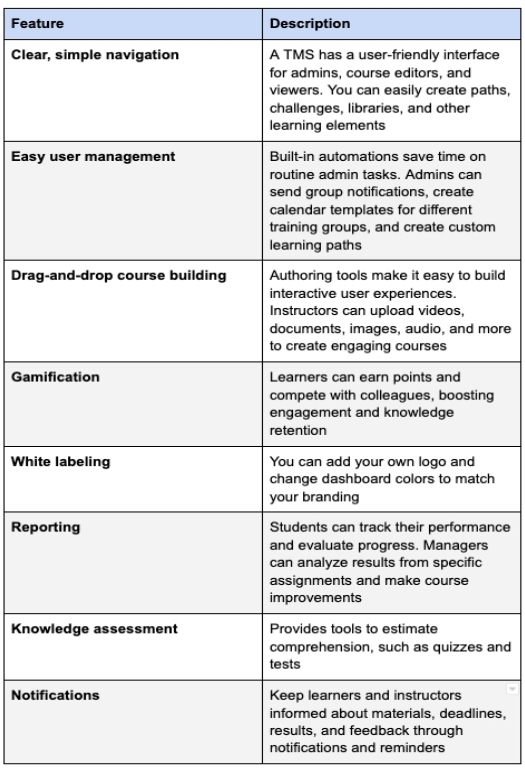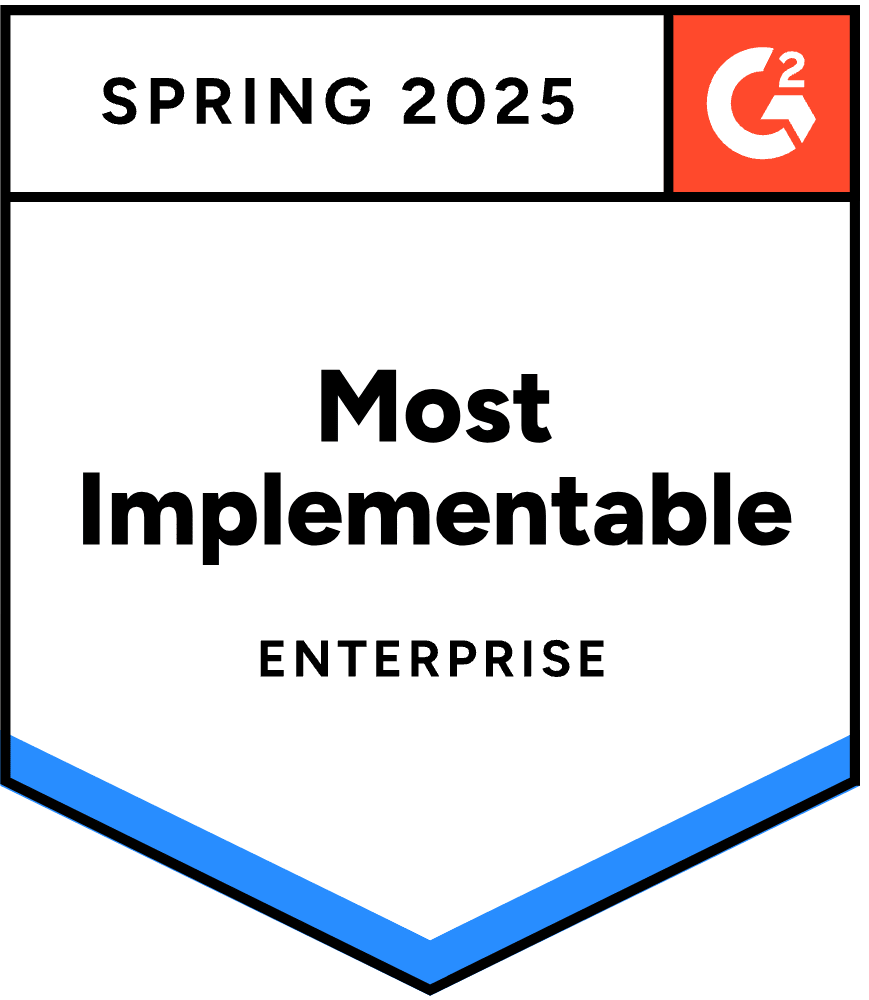The Ultimate Guide to Training Management Software
Michael Keenan | WorkRamp Contributor
View bioLearning Tips Straight to Your Inbox
Employee training has come a long way from overhead projectors and smartboards. Education has benefited from the internet, which allows learning to extend beyond time and space constraints.
Digital learning hours are at their highest ever. In 2021, 80 percent of all learning hours were delivered using technology-based methods, like training management software.
The primary purpose of training management software when it first came out was to share course content. In the decades since it’s evolved into a comprehensive learning management system (LMS) that helps you:
- Design, manage, scale, and analyze training programs
- Manage certifications and qualifications for employees, teams, and partners
- Schedule and assign training courses
The best training management software can help you develop training courses that increase knowledge retention, engagement, and your bottom line. But since every business has different needs, how do you identify the best software option for your organization?
We can help you find the answer. We’ll discuss 11 of the most important features and capabilities to look for in training management software and answer FAQs about online training management systems, including:
- What is training management software, and how does a cloud-based training management system work?
- How is training management software different from learning management software, training tracking software, or customer relationship management (CRM) software?
- What are the benefits and drawbacks of training management software?
In this post:
What is training management software?
Training management software allows you to implement, organize, maintain, and scale training programs, which can be designed for your customers, partners, employees, or other parties.
Companies and specific departments within them, such as human resources (HR), frequently use training management software to reduce costs and streamline their training management process.
Just how frequently? As of 2020, nearly three-quarters of L&D departments—a total of 70 percent—reported using an LMS to manage their training programs, including 42 percent of Fortune 500 companies. And the vast majority of HR leaders—89 percent—agree that constant employee feedback and training are essential, according to Zippia.
While some overlap exists, training management software differs from learning management software, training tracking software, or customer relationship management (CRM) software. However, WorkRamp’s all-in-one platform is flexible enough to address each of these needs.
Read on to learn about these solutions and discover which is right for your organization.
Training management software vs. learning management software
Training management software is used to create, deliver, organize, and revise or update training content, which can be designed for internal or external use. For example, your organization might need to deliver compliance training to meet legal requirements or industry regulations.
Learning management software, or a learning management system (LMS), is a cloud-based system that helps organizations manage employee and customer learning, either in real-time or through self-paced (asynchronous) courses. Learning management software can be used to onboard new hires, create online lessons, enable your sales teams, or train employees and customers.
While its functionalities vary, think of an LMS as a framework to support learning and education. Learn more about what an LMS is and why your business needs one.
Training management software vs. training tracking software
Training management software enables organizations to manage various training-related content and programs. For example, a company might use training software for employee reskilling to close a skill gap or respond to changes in the industry.
As its name suggests, training tracking software serves a more specialized purpose: enabling businesses to track and monitor training-related data, like which types of training are due for renewal by which employees. By tracking employee training, organizations can improve workplace safety, ensure they are in compliance with legal requirements, and equip their teams with the knowledge and skills to remain competitive.
You can reduce costs and strengthen your L&D programs by choosing a platform that enables you to build and track training programs, like WorkRamp’s powerful all-in-one LMS.
Learn more about the purpose and benefits of training tracking software, including four ways it boosts your onboarding ROI.
Training management system vs. CRM
Training management software manages employee training programs, while CRM software manages customer relationships.
- Training management software aims to help companies keep track of their employee training. Things like scheduling training sessions, tracking who’s completed which training courses, and generating reports on their effectiveness might be part of this.
- Customer relationship management (CRM) systems help businesses manage customer relationships. You might have to store customer contact info, track sales and marketing leads, and deal with customer service inquiries.
Although they involve using specialized software to organize and manage important information, they’re two completely different things that serve different purposes.
How does a training management system work?
A training management system (TMS) is a cloud-based software for online training and learning activities. L&D teams invest in training software solutions to streamline their training program and centralize data.
With training software, you oversee the entire training process from a single platform. A training manager can quickly assign and reassign courses, and learners can access training materials anytime. The data a TMS provides gives you valuable insights into the effectiveness of your training content and methods.
It covers three core elements of a successful corporate training initiative:
- Course management: You can create, approve, and manage eLearning courses within the system. It’s easy to track course titles, descriptions, and engagement.
- Learner management: You can keep track of learners across online courses and make data-driven decisions about which courses are right for each learner.
- Training scheduling: You can automate course scheduling and ensure that the right learners are enrolled and which trainers are available.
Admins save time and money on running training programs. With a TMS, you can build a learning engine that drives business outcomes and maintains a competitive advantage.
Employee training management software vs. customer training software
Training management systems are ideal for businesses that want to create immersive training experiences. They help various groups—like organizations, students, and managers—organize and manage their training programs.
These training programs can target employees or external parties, such as your brand’s partners and customers. Whether your goal is to upskill your workforce or teach your customers how to use your product, software enables you to swiftly deploy training programs that are engaging, accessible, and cost-efficient.
Here are some internal and external use cases for training management software:
Internal use cases (for employees):
- Track all training materials and courses your company offers
- Run both self-paced and instructor-led training activities in one place
- Keep certifications up-to-date
- Create customized modules tailored to individual employee training needs
- Track employee progress and assign assessments to measure understanding
- Measure the cost-effectiveness of training and onboarding programs
- Identify learning trends and cost-effective learning methods
External use cases (for partners and customers):
- Access a network of expert instructors and courses to ensure top-notch training
- Provide eLearning materials, tutorials, and webinars to customers and partners
- Build interactive experiences for external parties
- Use data to ensure partner training is effective and efficient
Employee training management software types
Employee training may cover various topics, skills, and policies, from safety on the job site to diversity and inclusivity.
WorkRamp’s centralized platform empowers you to manage numerous types of internal training at all stages of the employee life cycle, from onboarding new hires to upskilling long-time team members as they transition into more senior roles.
Along with onboarding and upskilling, here are a few additional types of employee training programs that can be managed via software:
- Anti-bias and diversity training
- Compliance training
- Customer service training
- Leadership development training
- Product training
- Reskilling and cross-skilling (cross-training)
- Sales enablement training
- Technical/IT training
Customer training software types
While employee training aims to create a more skilled and productive workforce, customer training aims to boost product adoption—and customer loyalty—by educating people about the value and functionality that your product or service is capable of delivering.
Data shows that customer education programs can increase bottom-line revenue, decrease customer support-related costs, and provide other benefits to businesses that offer them. For example, one study showed that companies that have customer education programs boost bottom-line revenue by more than six percent.
So, what types of customer training can software be used to deliver and manage?
The ideal platform should be versatile enough to accommodate all types of training methods and learning modalities, such as:
- Customer certification programs
- Customized instructor-led training
- eLearning content and courses
- Live or on-demand webinars
- Long- and short-form video content
- Online training academies
- Text articles and self-service help centers
Training management software pros & cons
Corporations, school districts, and other organizations can benefit in multiple ways by using software to manage their internal and/or external training programs.
To provide a powerful example, data shows that adopting training management software can increase your organization’s profit margins by up to 24 percent. The same research indicates that companies can improve employee retention by as much as 34 percent.
Read on to learn more about the benefits of training management systems, along with some of their limitations—and how the right software can help you overcome them.
Benefits
- Improved productivity: Organizations can save time and resources by automating time-consuming tasks, such as scheduling training sessions and tracking learner progress.
- Better collaboration: Training platforms let trainers and employees share information, collaborate on projects, and communicate, which can improve teamwork.
- Better tracking and reporting: You can easily report on and evaluate the effectiveness of your training programs with a training management system.
- Increased flexibility: Employees can access training wherever they are so that organizations can train according to schedules and locations.
- Improved compliance training and risk management: Companies can reduce the risk of non-compliance by using training management systems to ensure employees get the training they need.
- Higher employee engagement: Employees can learn more effectively with training management systems, which can motivate and engage them.
- Cost savings: An effective training management system can help organizations cut training costs, like hiring trainers, buying materials, and providing travel and accommodation.
Limitations
Some training management software has limitations that could weaken your ability to boost productivity or reach other goals.
For instance, legacy LMS systems may not necessarily scale quickly, support custom learning paths, provide easy ways to build courses, or integrate with all of the platforms you want.
This underscores the need for your business to choose a training platform that aligns with your needs, offers powerful features, and—most importantly—delivers measurable results.
By harnessing all-in-one training management software like the Learning Cloud from WorkRamp, businesses can avoid these limitations for a frictionless experience. Our scalable platform supports dozens of integrations, makes course-building easy, allows you to create personalized learning pathways, supports interactive courses, and more.
Training management software key features
Now that you know the basics of training management systems, it’s time to dig deeper and look at some of their specific functionalities.
Here are 11 key features that should be included in your training management software.

Course-building capabilities
The ideal software should include authoring tools that enable you to easily create interactive user experiences.
You should be able to effortlessly upload and share images, videos, text documents, and other media types to build personalized, engaging courses. WorkRamp’s platform gives you the tools to design training programs around L&D, sales enablement, support enablement, revenue development, and more.
Monitoring of training status
The best training software allows you to easily track and monitor employees’ skill sets, performance, and training progress.
This data can be used to determine who has completed which training requirements, who needs to improve which skills, what training still needs to be assigned, who should be reskilled or upskilled, and more.
Automated training workflows and admin tasks
Built-in automations save admins time on routine tasks, such as sending emails, alerts, and notifications or uploading employee data.
Look for a platform like WorkRamp that allows administrators to automate training assignments and workflows, such as HR workflows, so your team can focus on tackling its most important projects.
By leveraging automation, you can accomplish in just a few clicks what would have taken hours or days of manual work in the past.
Reporting and analytics
Data provides insights that can be translated into improvements to your training program, which enables you to achieve better business outcomes and maximize your ROI. Therefore, it’s crucial to choose software with custom reporting and analytics.
WorkRamp lets you tap into powerful analytics and reporting dashboards that make it easy to keep tabs on the performance of your customer, partner, and employee training programs. For example, our Salesforce dashboards let you assess your program’s direct impacts on customer revenue over time.
Customizable learning paths
According to a statement from consulting firm Gartner, “Our research shows that 82 percent of employees say it’s important for their organization to see them as a person, not just an employee, yet only 45 percent of employees believe their organization actually sees them this way.”
Additional research by Gartner shows that 47 percent of HR leaders are making it a priority to improve the employee experience in 2023. Meanwhile, research by Zippia found that “91 percent of employees want personalized training.”
Personalization is more than a hot trend in business development—it’s an essential capability to look for in training software. WorkRamp’s platform allows administrators to easily segment users and groups to create customized learning paths, which boosts learner engagement—and in turn, your organization’s profitability.
Interactive elements
Like personalization, interactivity is another emerging trend in corporate training programs.
Traditional software suffers from a lack of interactivity, but WorkRamp’s interactive platform makes training sessions fun and memorable. Use elements like challenges, quizzes, and flip cards to boost engagement and knowledge retention.
White-labeling
White-labeling increases brand visibility, reduces costs, and strengthens customer trust and loyalty, making it a powerful strategy for businesses.
WorkRamp’s training software allows you to white-label and customize our LMS to suit your requirements, like changing dashboard colors and adding your logo to match your branding.
You can also customize your navigation, registration, and course overview pages, along with external academy certifications to represent your brand.
Compliance tracking
Compliance training is critical to ensure your company meets regulations and is not in jeopardy of receiving fines or penalties.
Staying compliant also helps you maintain your brand’s positive reputation—along with your ability to operate safely and productively.
Last but not least, compliance training ensures that your team members are equipped with the knowledge and skills required to perform their tasks competently—for instance, training around HIPAA compliance in the healthcare industry or compliance with FTC regulations in the financial industry.
The takeaway is that better compliance equals fewer headaches—and it all starts with an organized, centralized system for managing your compliance training data and content. Look for a platform that makes it easy to organize HR documents, build compliance training programs, monitor who’s due for retraining, and track training progress and course completion.
Easy user interface
Even the most powerful training software won’t be helpful for your employees or customers unless it’s also easy to navigate and use.
WorkRamp’s streamlined LMS was designed to deliver a seamless, intuitive experience for end-users and admins alike.
Knowledge assessment
Training software should provide you with ways to assess users’ mastery of the training content.
For instance, you should have the ability to create tests and quizzes. Knowledge assessments will enable you to spot areas for improvement, allowing you to optimize your training programs and ensure that the information is being absorbed.
Integrations
Integrations are another critical feature to look for when =evaluating potential training management solutions.
WorkRamp’s flexible platform integrates with 36 of the most popular tools for HR, sales, content, analytics, scheduling, and single sign-on (SSO).
For example, you can integrate your TMS with Slack so people can receive notifications for events and deadlines in a Slack feed. Other powerful platforms that WorkRamp integrates with include:
- Salesforce
- Zendesk
- Okta
- Workday
- Udemy
This allows you to build an all-inclusive, frictionless online learning experience by leveraging your existing tech stack.
How to choose the best training management software
Now that you know what features to look for, such as data reporting, integrations, and white-labeling, you can make an informed decision about the right training management software for your organization.
To ensure you choose the best fit for your needs, here are a few final considerations to keep top of mind.
Organizational use cases
Consider your organization’s specific goals and priorities, then choose a platform that aligns with your training needs. For instance, maybe you’re looking to increase productivity or decrease your rates of employee churn during onboarding. There are numerous internal and external use cases that WorkRamp’s all-in-one platform can be used for, including certification programs, interactive eLearning, tracking training progress, and more.
Customizations
Customization is key to building engaging, effective programs. WorkRamp goes beyond standard white-labeling and offers more branding elements than any competing employee training platform, including:
- Custom online courses
- Custom learning paths
- Custom quizzes and tests
- Customizable dashboards
- Customizable navigation, registration, and course overview pages
- Customizable social sharing
Our hyper-customizable platform is built to support and represent your brand.
Software scope
Consider the functionality you need to meet your objectives. For example, are you specifically looking for software to help manage your customer relationships? Or would your organization get more significant benefits from a comprehensive learning management system?
Whether you’re looking to target a specific pain point or give your systems a top-to-bottom overhaul, WorkRamp offers a range of solutions to meet your unique needs.
Proven training ROI
Ensure that you’re getting results from your training programs with WorkRamp’s customizable dashboards, which enable you to track the performance metrics that matter most. Track metrics like training sign-up rates, number of active users, results of tests and quizzes, and completion rates—or set up your own metrics to calculate the ROI on your training investment.
In-person vs. virtual options
While in-person training brings its own value to the table, many companies are leveraging virtual training as a cost-efficient supplement to, or replacement for, traditional on-site training programs.
For instance, some benefits of virtual employee training include:
- Ability to offer a wide range of course topics
- Lower cost of training per employee
- Numerous learning modalities and lesson types can be incorporated, such as microlearning and spaced learning
- Training is convenient and easy to access for users
Budget
Going over your budget eats into your ROI and makes it harder to keep your training programs running.
Look for a platform that offers flexible payment options and doesn’t lock you into a long-term contract.
Use the vest training management software for your business
A cloud-based training management system gives employees and customers a complete and engaging learning experience. The best training management software will help you be more productive, manage eLearning content, and educate your people from anywhere, at any time.
With an all-in-one learning platform like the Learning Cloud from WorkRamp, you can build and launch impactful employee, customer, or partner training programs quickly and easily.
Contact us to learn more about how WorkRamp can help you build your organization’s training management system.
Complete the form for a custom demo.
Recent Posts
- Introducing WorkRamp Analytics Studio: Unlocking Your Data Insights with AI June 30, 2025
- 11 AI LMS for AI-Powered Learning June 27, 2025
- The Best LMS Platforms for Customer Retention (2025 Guide) June 27, 2025
- 11 Best AI Learning Platforms June 16, 2025
- Top AI LMS Features (and Why They Matter in 2025) June 16, 2025
Michael Keenan
WorkRamp ContributorMichael is a SaaS marketer living in Guadalajara, Mexico. Through storytelling and data-driven content, his focus is providing valuable insight and advice on issues that prospects and customers care most about. He’s inspired by learning people’s stories, climbing mountains, and traveling with his partner and Xoloitzcuintles.
You might also like
Discover how increasing your L&D budget benefits your team and your organization
Your team is your greatest asset, and investing in their learning and development benefits your business.
Read More
How to make learning a competitive advantage
Industry experts share actionable strategist to shape your L&D program and boost employee engagement.
Read More
Simple steps to promote continuous learning and improvement
Check out these three actionable ways to expand and improve your L&D program.
Read More
Decrease Ramp Time and Increase Revenue
Get in touch to learn how WorkRamp can help you achieve your learning and development goals.
Request a Demo




